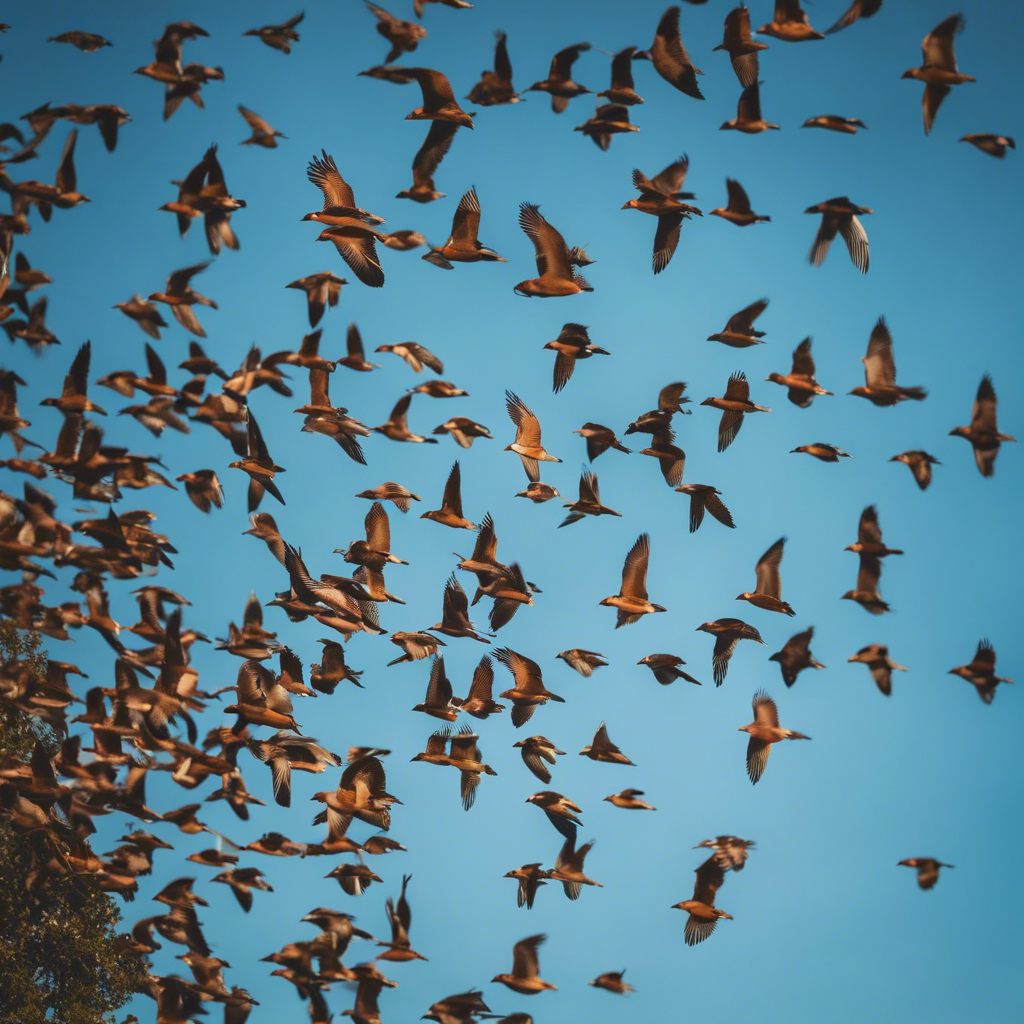You may have heard the phrase ‘bird-brained’ used to describe someone forgetful or scatterbrained, but it turns out that birds possess quite impressive memory skills.
In fact, some bird species exhibit memory abilities that rival those of primates and even humans.
Birds rely on their memories for various essential activities such as navigation during migration, communication through song learning, food storage and retrieval, and even facial recognition.
Each of these aspects contributes to their survival in the wild and highlights the importance of understanding bird cognition.
So next time you hear someone being called ‘bird-brained,’ remember that it might actually be a compliment!
Types of Bird Memory
You might be surprised to learn that our feathery friends possess various types of memory, just like we do! Avian intelligence is a fascinating area of study, and researchers have found that birds exhibit remarkable memory retention in different ways.
Some bird species are known for their incredible problem-solving abilities, such as crows and parrots, which can remember complex tasks and even mimic human speech. Other birds possess spatial memory skills that enable them to locate thousands of hidden food caches over vast areas.
In addition to these impressive cognitive feats, birds also rely on their memories for various survival activities such as recognizing predators or remembering the locations of safe nesting sites. Furthermore, some bird species demonstrate social learning by observing and memorizing the behaviors of their peers. This ability to learn from others is yet another example of how avian intelligence goes beyond just instinctual behavior.
As you continue exploring the world of bird memory, you’ll soon discover how essential it is for navigation and migration purposes.
Consider how homing pigeons rely on their remarkable memory to find their way back home, even over vast distances.
Reflect on the fact that geese and other migratory birds use a combination of memory, environmental cues, and innate instincts to navigate their long journeys with precision.
Engage in a discussion about the fascinating role memory plays in bird navigation and migration across various species.
Homing Pigeons
Think about homing pigeons, for example – they’re known to remember their home base and return there even after traveling great distances, like the famous G.I. Joe pigeon that delivered crucial information during World War II. These birds have remarkable memories and navigational skills that allow them to participate in events such as pigeon racing, where they compete based on speed and accuracy in returning to their homes.
Pigeon racing strategies and homing pigeon care are essential aspects of their success. Regular training helps pigeons develop muscle strength, endurance, and improve their navigational abilities. A balanced diet rich in proteins, vitamins, minerals, and carbohydrates is essential for maintaining the health and stamina needed for long-distance flights.
Housing is also crucial. Provide a clean, dry loft with proper ventilation that protects them from predators and harsh weather conditions. Regular check-ups by avian veterinarians help prevent diseases or treat any existing health issues.
These incredible abilities displayed by homing pigeons further prove that birds indeed possess strong memory capabilities. As we continue exploring bird memory skills, let us turn our attention to geese and other migratory birds who also showcase impressive navigation talents.
Geese and Other Migratory Birds
Geese and other migratory birds truly demonstrate remarkable navigation skills, painting a vivid picture of their extraordinary memory capabilities. One fascinating aspect of geese behavior is imprinting, wherein young geese instinctively follow the first moving object they see after hatching, usually their mother. This forms a strong bond between the goslings and their parent, allowing them to learn essential survival skills and recognize others of their species. Geese imprinting highlights the critical role memory plays in the early stages of life for these animals.
Additionally, migration patterns also showcase the impressive memory abilities of migratory birds such as geese. They can remember specific routes that span thousands of miles over varying terrains and weather conditions to reach breeding or wintering grounds.
Not only do these incredible navigational feats reveal an astounding capacity for spatial memory in geese and other migratory birds, but they also indicate an ability to adapt to changing environments along their journeys by recalling previous experiences. As more research unfolds on this subject matter, it becomes increasingly clear that bird brains are highly specialized for memory-dependent tasks – something worth considering when observing these creatures’ unique behaviors.
With this understanding in mind, let’s explore how memory plays a vital part in bird communication and song learning.
Memory in Bird Communication and Song Learning
It’s fascinating how bird communication and song learning can showcase their remarkable memory capabilities. Song dialects, for example, are regional variations in bird songs that are passed down through generations, demonstrating the ability of birds to learn and remember these distinct vocal patterns. Mimicry abilities are another testament to their impressive memory skills; some species like mockingbirds and lyrebirds can memorize complex sequences of sounds from other birds or even human-made noises.
Here are three striking examples that show just how amazing bird memory is when it comes to communication and song learning:
Song sparrows: These small birds have the ability to learn up to 20 different songs during their lifetime, remembering each tune as they use them in various social interactions.
European starlings: They can recognize specific vocalizations produced by other individuals within their group, allowing them to differentiate between friends and potential rivals.
Zebra finches: These little birds not only memorize their fathers’ unique songs but also pass them on to future generations, showcasing an intriguing form of cultural transmission in the animal kingdom.
Next, let’s explore how avian memory plays a crucial role in food storage and retrieval strategies for many bird species.
Memory in Food Storage and Retrieval
You’d be amazed at how crucial memory is for many bird species when it comes to food storage and retrieval strategies. Food caching strategies are essential for the survival of several bird species, especially those living in harsh environments with limited food availability during certain times of the year.
Birds like corvids (crows, jays, and magpies) and some songbirds are known to hide food items in numerous locations called caches, often burying them in the ground or tucking them away in tree crevices. To successfully retrieve these stored food items later on, birds rely heavily on their spatial memory – their ability to remember specific locations and landmarks associated with each cache site.
Not only do these birds remember the approximate location of each cache site, but they also keep track of various factors such as the type and perishability of stored food items, allowing them to prioritize which caches should be retrieved first. This demonstrates an impressive level of cognitive ability among these avian species that enables them to survive better in their respective habitats.
Furthermore, studies have shown that some birds can even remember cache sites after months or even years have passed since they first stored food there. In addition to helping birds thrive through tough seasons by ensuring a reliable supply of nourishment, this remarkable memory skill also plays a role in more social aspects of avian life – such as recognizing individual faces within their communities.
Birds and Facial Recognition
When discussing birds and facial recognition, it’s important to consider how certain bird species are known to recognize human faces. They remember those who have posed a threat or provided food.
Additionally, it’s fascinating to delve into the world of birds’ ability to recognize other birds. They use visual cues like plumage patterns and coloration to identify individual members within their social groups.
It’s important to keep in mind that these abilities can vary greatly between different bird species. They may be linked to their overall cognitive capacity and ecological requirements.
Recognizing Humans
You might be surprised to learn that our feathered friends are quite capable of recognizing individual humans, showcasing their impressive cognitive abilities. This skill demonstrates the depth of avian intelligence and suggests that birds may even form human attachments in some cases.
Various studies have shown that birds can differentiate between people based on facial features, clothing, and other physical characteristics. Some notable examples of bird species known for their ability to recognize humans include:
- Crows: Known for their remarkable problem-solving skills and adaptability.
- Magpies: These intelligent birds have been observed recognizing human faces.
- Pigeons: With excellent spatial memory, pigeons can identify individuals who feed them regularly.
- Parrots: As highly social creatures, parrots are known to bond with their human caretakers.
- Chickens: Studies have shown that chickens can distinguish between more than 100 different faces.
Birds’ ability to recognize humans not only highlights their impressive cognitive capabilities but also serves as a reminder of the complex relationships they share with us.
In the next section, we’ll explore how these fascinating creatures apply this recognition skill when interacting with other members of their own species.
Recognizing Other Birds
Having explored the fascinating ability of birds to recognize humans, it’s worth considering whether they are also capable of recognizing fellow birds. This is an essential aspect in understanding bird behavior and social dynamics, as well as their emotions and cognitive abilities.
Bird friendships exist within various species, suggesting that these creatures can indeed remember and recognize each other. For example, some songbirds form long-term partnerships or even lifelong bonds with specific mates. These connections demonstrate the presence of avian emotions and an ability to distinguish between individual birds.
Furthermore, studies have shown that certain species like corvids – which include crows, ravens, and magpies – possess impressive problem-solving skills and exhibit a range of complex social behaviors such as cooperation, deception, and even mourning for deceased companions.
Overall, evidence points to a strong capacity for memory among birds when it comes to identifying others within their community.
Frequently Asked Questions
How does a bird’s memory compare to that of other animals, such as mammals or reptiles?
Picture yourself surrounded by a flurry of feathers, witnessing the fascinating world of avian intelligence.
Birds, like mammals and reptiles, have varying memory capabilities across different species. Memory training plays a crucial role in understanding these creatures’ cognitive abilities.
Research has shown that some bird species exhibit remarkable memory skills, even rivaling those of primates! For example, crows can recognize human faces and remember them for years, while pigeons can recall hundreds of images with impressive accuracy.
In comparison to reptiles, birds generally possess more advanced cognitive functions due to their highly developed brain structures. However, it’s important to note that individual differences exist within each animal group – so don’t underestimate the memory prowess of our scaly friends either!
Are there any specific factors that can impact or improve a bird’s memory, such as diet or environmental conditions?
Yes, there are specific factors that can impact or improve a bird’s memory, such as diet and environmental conditions.
Memory enhancing techniques, like exposing birds to complex environments with various stimuli, can promote cognitive development and boost their memory capacity.
Additionally, a well-balanced diet rich in essential nutrients, like antioxidants and omega-3 fatty acids, also plays a crucial role in maintaining optimal brain health and improving memory functions.
Environmental impacts, such as pollution or habitat loss, may negatively affect a bird’s memory by causing stress or limiting access to resources that support cognitive growth.
Therefore, ensuring your avian friends have access to stimulating surroundings and a nutritious diet can significantly enhance their memory abilities.
Do birds display any signs of memory loss or deterioration as they age, similar to humans and other animals?
Just as you may misplace your keys or forget a name, birds too can experience avian amnesia, especially as they age.
Memory deterioration in birds is similar to that in humans and other animals, with older birds often exhibiting signs of memory loss.
To combat this natural decline and promote memory preservation, factors such as diet and environmental conditions come into play.
It’s essential for bird enthusiasts to pay close attention to their feathered friends’ needs throughout their lifespan – ensuring they receive proper nutrition, mental stimulation, and social interaction – which can all contribute to maintaining a healthy bird brain well into their golden years.
Can birds learn from and remember interactions with humans or other species, and do these memories influence their behavior?
You might be fascinated to learn that birds can indeed remember and learn from interactions with humans or other species, which can influence their behavior.
Bird emotions play a significant role in their ability to form memories and interact with other beings. Memory training is particularly evident in species like parrots, crows, and pigeons that display advanced cognitive skills.
These birds have been observed using tools, solving complex problems, recognizing human faces, and even mimicking speech – all of which are clear signs of memory retention and learning abilities.
As they gain experience through these interactions, their behavior evolves accordingly, showcasing the astonishing adaptability of our feathered friends.
Are there any notable differences in memory capabilities between different bird species, and if so, what factors contribute to these differences?
Yes, there are notable differences in memory capabilities among different bird species, largely influenced by factors such as avian intelligence and the specific demands of their ecological niches.
Memory training plays a significant role in enhancing these abilities, with some birds displaying remarkable aptitude for learning and remembering complex tasks.
Corvids and parrots, for example, are known for their exceptional cognitive skills, which enable them to solve problems, use tools, and even mimic human speech. These advanced mental capacities stem from having larger brains relative to their body size and more developed forebrains – areas responsible for decision-making and problem-solving.
On the other hand, smaller bird species may exhibit less sophisticated memory skills due to their more modest brain structures and ecological requirements.
Overall, various factors such as genetics, brain morphology, environmental demands, and sociality contribute to the range of memory capabilities observed across different bird species.
Do Birds’ Memory Affect Their IQ?
The discussion surrounding birds’ intelligence and cognitive abilities often leads to questions about their memory. Researchers are intrigued by how memory impacts IQ in birds. While a direct correlation isn’t fully understood, studies suggest that birds’ memory plays a significant role in their problem-solving skills and adaptability. Further research is needed to unravel the intricacies of birds’ memory and its impact on their overall intelligence.
Conclusion
So, do birds have a memory? You bet they do! In fact, their remarkable memory abilities can be seen in navigation, communication, food storage, and even facial recognition.
One fascinating statistic to grab your attention is that some species of birds can recognize human faces – with research showing that crows can remember a person’s face for up to five years!
It’s safe to say that the world of bird memory is vast and impressive.

An avid ornithologist, zoologist and biologist with an unwavering passion for birds and wild animals.
Dr. Wilson’s journey in ornithology began in childhood and led him to obtain a Ph.D. in Ornithology from the prestigious Avian Research Institute. He has worked closely with renowned experts in the field and conducted extensive research and field studies globally.



